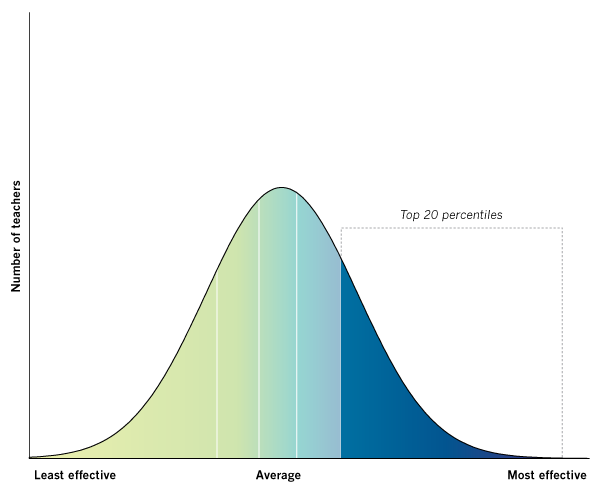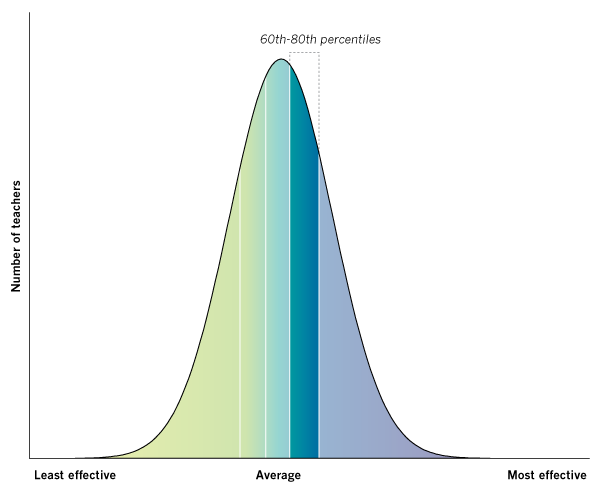Andrew Stephen Warner
A 5th grade teacher at Frank del Olmo Elementary in 2009
These graphs show a teacher's "value-added" rating based on his or her students' progress on the California Standards Tests in math and English. The Times’ analysis used all valid student scores available for this teacher from the 2002-03 through 2008-09 academic years. The value-added scores reflect a teacher's effectiveness at raising standardized test scores and, as such, capture only one aspect of a teacher's work.
Compared with other Los Angeles Unified teachers on the value-added measure of test score improvement, Warner ranked:
- Most effective overall.
- Most effective in math. Students of teachers in this category, on average, gained about 11 percentile points on the California Standards Test compared with other students at their grade level.
- More effective than average in English. Students of teachers in this category, on average, gained about 2 percentile points on the California Standards Test compared with other students at their grade level.
Warner's LAUSD teaching history
2002-03 through 2008-09 academic years
- Frank del Olmo Elementary, 2009 - 2007
- Cahuenga Elementary, 2006
Andrew Warner's Response:

I think that a healthy dialog regarding how to gather and use data to measure teacher effectiveness is good, as long as it is coupled with a healthy dialog on how to address the other areas that impact a student's academic success, among these of which are, in no particular order: (1) Student effort as evidenced by student attendance and homework completion rate; (2) the District selected curriculum and the effectiveness of training teachers in this curriculum, which in large part impacts teaching as these are the tools we teachers are given; (3) parental involvement and a stable, loving home; (4) the prior level of achievement and mastery of the student; and (5) the leadership provided by the school's principal and administrative team. I as a teacher try to do everything I can to make my students effective, as I truly believe that all students can achieve success, but also realize that I do not control everything that goes into the success or lack thereof of my students.
How do you measure whether or not a student is putting in their best effort? Perhaps homework completion and attendance could be a measure of this. For the most part, my students do well in completing their homework as they know that they will stay in during recess to finish what was missing, but I have still had cases where a student does little or no homework, despite repeated conversations with parents and having positive and negative consequences for homework completion.
How do you measure the effectiveness of the curriculum chosen by the District? I do my best to guide my teaching based on the state standards, not necessarily the curriculum, but there is a limit to what a teacher can create or find on his or her own when the curriculum that has been handed to him or her doesn't cut the mustard for a particular standard, or does not teach the standard in a way that one's students understand. Also, how well does the District curriculum match the diverse needs of its students? For example, LAUSD uses Open Court for its elementary language arts program, which essentially has only one reading level per grade (in contrast, when I worked as a teacher in Chula Vista a student's reading instruction was based on his or her actual reading level, not his or her grade level). Is this the best approach in a district that has such a high level and range of English Language Learners? How do you measure the impact of district-wide decisions on the effectiveness of teachers?
Thirdly, how do you measure the effectiveness of parenting on a student's academic success? Again, homework completion rate may be one of many measures of this. It also surprises me that one of the things that most impacts our society is the raising of children, and that no parenting classes are required for high school graduation (the other area that greatly impacts our society where virtually no education is given prior to high school graduation is the area of money management).
Fourth of all, how do you account for a student's prior level of achievement? Obviously, a student who has developed his or her academic skills further than others is more prepared for their new grade level when they move up. Also, how come we socially promote students systematically in the elementary years? There should be some clear minimum threshold that must be achieved to move on the next grade level. Otherwise, what is being communicated to the student by this system of social promotion is that it doesn't matter if you work hard or not, you're still going to move on to the next grade level. Then we wonder why many students start dropping out in middle school and high school when they flunk, or as I can attest to as a fifth grade teacher, students arriving many years behind when they start a new grade level. Accountability for the student should start early. It should also be obvious that if a student is not being held accountable in some meaningful way for his or her performance when it comes to moving up a grade level, how do you realistically expect that student's performance on a standardized test to be reflective of the quality of the teaching?
Finally, how do you measure the effectiveness of the local school site leadership? How do you know whether the leadership provided results in teachers becoming better each year, or whether the leadership provided does not encourage growth as a teacher? I have worked under three different principals in two different school districts (my first three years of teaching were at Feaster-Edison Charter School in the Chula Vista Elementary School District), and can say that all three principals managed their schools in different ways and thus produced different results. In one school we were given at least four hours per week of paid time to collaborate with colleagues, were visited by an administrator at least once a week during random, unannounced times to have our teaching observed (with feedback and questions given to foster reflection on one's own teaching), and had professional development that was meaningful, engaging, and provided strategies that were clearly implementable in our classrooms. Clearly, this administrator knew what was happening in the classrooms at his school, and his meaningful involvement established him as an academic leader in the eyes of the teaching staff. The feedback and collaboration also resulted in new teachers receiving the support they needed to establish themselves as professional educators. In contrast, at another one of my schools, I was rarely visited while teaching (perhaps once every two to three months), and when I was visited, was not always given feedback. When I was given feedback, it was easy to see that this administrator was out of touch with what was happening in the classroom, perhaps because this administrator rarely set foot in one. Collaboration was expected to happen on teachers' own times, which meant that with every teacher having different schedules and commitments on "their own time", collaboration rarely happened. Time was inconsistently given for grade-levels to meet for an entire day on some months and only a few times for one hour in a week, but for the most part these were top-down and not responsive to the needs of the grade level or the needs of the teachers or their students. Professional development was for the most part very abstract, with no concrete strategies given to teachers and no time given for teachers to collaborate on meaningful ways to implement strategies in the classroom. It is easy to see how the lack of collaboration, meaningful professional development, or guiding administrative presence in the classroom itself lent itself to producing new teachers who were not consistently effective, and also lent itself to the inability to determine whether a lack of effectiveness was due to a lack of support or due to a person not having the right qualities to be an effective teacher. How do you measure the impact of local school-site decisions on the effectiveness of teachers?
To conclude, I hope that this has shown that while a teacher is a very important part of the equation in producing successful students, that the teacher is not the only highly significant part. I also hope that I have shown that the teaching that is imparted in the classroom, while reflecting in a large part on the teacher, is also a large reflection on the choices that districts and school-site administrators make and implement. All these questions and observations that I have made have been done so in the spirit of finding ways to improve our system of educating our next generation of people. None have been made in the spirit of complaining, but in the spirit of trying to point out how things really are, because that is what allows us to strategize and move forward in a better way. I challenge the LA Times to provide meaningful research in these other factors I have mentioned, as only a wholelistic approach will result in the re-creation of our schools as a world-class education system.
![]() The Times gave LAUSD elementary school teachers rated in this database the opportunity to preview their value-added evaluations and publicly respond. Some issues raised by teachers may be addressed in the FAQ. Teachers who have not commented may do so by contacting The Times.
The Times gave LAUSD elementary school teachers rated in this database the opportunity to preview their value-added evaluations and publicly respond. Some issues raised by teachers may be addressed in the FAQ. Teachers who have not commented may do so by contacting The Times.
|
|
 Delicious
Delicious
|
 Digg
Digg
|
 Facebook
Facebook
|
 Twitter
Twitter
|









